Phát triển phần mềm là một thách thức lớn đối với nhiều tổ chức. Mặc dù mục tiêu cuối cùng là đảm bảo phần mềm hoạt động đúng hạn và nằm trong ngân sách dự kiến, nhưng thực tế lại cho thấy những con số đáng báo động. Theo các nghiên cứu, trung bình các dự án công nghệ thông tin vượt quá ngân sách lên tới 45% trong khi chỉ mang lại giá trị thấp hơn 56% so với kỳ vọng ban đầu.
Những thống kê này phản ánh một thực trạng đáng lo ngại trong lĩnh vực phát triển phần mềm. Tuy nhiên, không vì thế mà các tổ chức nên nản lòng. Thay vào đó, họ cần xây dựng một kế hoạch phát triển phần mềm vững chắc và chi tiết. Kế hoạch dự án đóng vai trò như một lộ trình, hướng dẫn toàn bộ nhóm phát triển đạt được mục tiêu cuối cùng.
Khi hợp tác với đơn vị gia công phần mềm bên ngoài, việc xây dựng một kế hoạch phát triển phần mềm chi tiết và rõ ràng càng trở nên quan trọng hơn. Kế hoạch này sẽ giúp định hướng, phối hợp và theo dõi các hoạt động giữa tổ chức của bạn và đơn vị gia công, đảm bảo dự án được thực hiện đúng tiến độ, đáp ứng yêu cầu kỹ thuật và nằm trong ngân sách. Trong kế hoạch, cần xác định rõ vai trò, trách nhiệm và quy trình làm việc của các bên liên quan, cũng như đặt ra các mốc thời gian, tiêu chí thành công và cách thức quản lý rủi ro.
Với kinh nghiệm và chuyên môn, Evotek – đối tác trong lĩnh vực gia công phần mềm sẵn sàng hỗ trợ bạn soạn thảo một kế hoạch dự án hoàn hảo, chi tiết trong 9 bước đơn giản nhưng hiệu quả.
Kế hoạch phát triển phần mềm là gì?
Trước khi đi sâu vào cách thức soạn thảo một kế hoạch phát triển phần mềm hiệu quả, chúng ta cần hiểu rõ bản chất và vai trò quan trọng của nó. Một kế hoạch phát triển phần mềm toàn diện phác họa lộ trình biến các yêu cầu của dự án thành một sản phẩm phần mềm hoạt động, từ giai đoạn ý tưởng ban đầu cho đến việc triển khai, vận hành và bảo trì sau này. Nó đóng vai trò then chốt trong việc định hướng, phối hợp và theo dõi tiến độ của toàn bộ quá trình phát triển, đặc biệt khi hợp tác với đơn vị gia công phần mềm bên ngoài.
Để bắt đầu xây dựng một kế hoạch phát triển phần mềm vững chắc, các nhà quản lý dự án cần trả lời một loạt câu hỏi quan trọng như:
- Công nghệ nào sẽ được sử dụng và những yêu cầu kỹ thuật cần đáp ứng?
- Ai sẽ đảm nhận vai trò quản lý dự án và điều phối các hoạt động giữa tổ chức và đơn vị gia công?
- Nhân sự và nguồn lực nào sẽ được huy động để hỗ trợ dự án, bao gồm cả nhân lực từ đơn vị gia công?
- Các bên liên quan chính là ai và mối quan hệ với họ như thế nào?
- Những phụ thuộc bên ngoài nào có thể ảnh hưởng đến tiến độ dự án, bao gồm cả các yếu tố từ phía đơn vị gia công?
- Tiêu chí thành công được xác định như thế nào để đánh giá dự án?
- Các mốc thời gian quan trọng và cách thức ước tính chúng, tính đến khả năng đáp ứng của đơn vị gia công?
- Chi phí ước tính là bao nhiêu và trên cơ sở những giả định nào, bao gồm cả chi phí thuê ngoài đơn vị gia công?
Bằng cách trả lời thấu đáo các câu hỏi này, nhóm dự án sẽ có được nền tảng vững chắc để xây dựng một kế hoạch phát triển phần mềm toàn diện và hiệu quả.
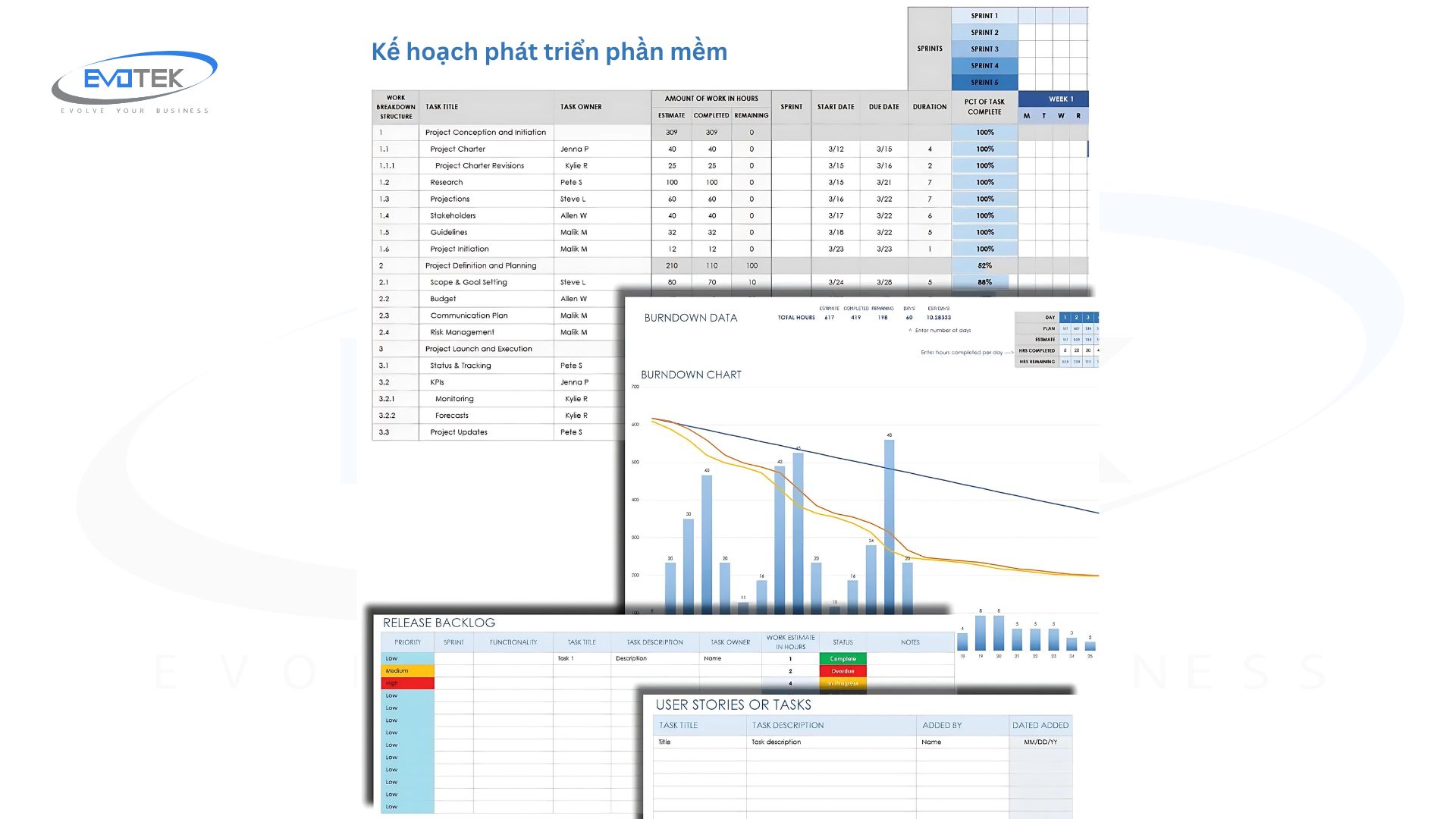
Tại sao bạn cần một kế hoạch phát triển phần mềm
Khi áp dụng phương pháp phát triển phần mềm linh hoạt, trong đó quá trình được định hướng, thử nghiệm và lặp đi lặp lại thay vì dựa trên các thời hạn cố định, có thể dẫn đến nghi ngờ về tầm quan trọng của việc lập kế hoạch dự án chi tiết. Mặc dù đúng là trong một số trường hợp, tiến độ phát triển có thể ưu tiên hơn so với việc tuân thủ nghiêm ngặt lịch trình và kế hoạch hoạt động, nhưng vẫn có nhiều tình huống mà kế hoạch dự án và các thời hạn cụ thể đóng vai trò quan trọng.
Trong trường hợp hợp tác với đơn vị gia công phần mềm, việc lập kế hoạch dự án chi tiết là rất cần thiết để đảm bảo sự thành công của dự án, quản lý kỳ vọng, phân bổ nguồn lực hiệu quả và phối hợp nhịp nhàng giữa các bên liên quan.. Khi làm việc với một đơn vị bên ngoài, cần phải xác định rõ ràng các mốc thời gian, yêu cầu về sản phẩm và quy trình làm việc để đảm bảo sự hiệu quả của dự án. Kế hoạch dự án sẽ giúp xác định rõ ràng phạm vi công việc, các giai đoạn phát triển và thời hạn hoàn thành từng giai đoạn. Điều này giúp đơn vị gia công phần mềm hiểu rõ các kỳ vọng của khách hàng và lên kế hoạch nguồn lực phù hợp.
Kế hoạch dự án chi tiết cũng giúp quản lý hiệu quả việc phối hợp và giao tiếp giữa khách hàng và đơn vị gia công. Nó xác định rõ ràng các cuộc họp, báo cáo và các điểm kiểm tra quan trọng, đảm bảo sự minh bạch và hiệu quả trong quá trình phát triển.
9 bước lập kế hoạch dự án phần mềm
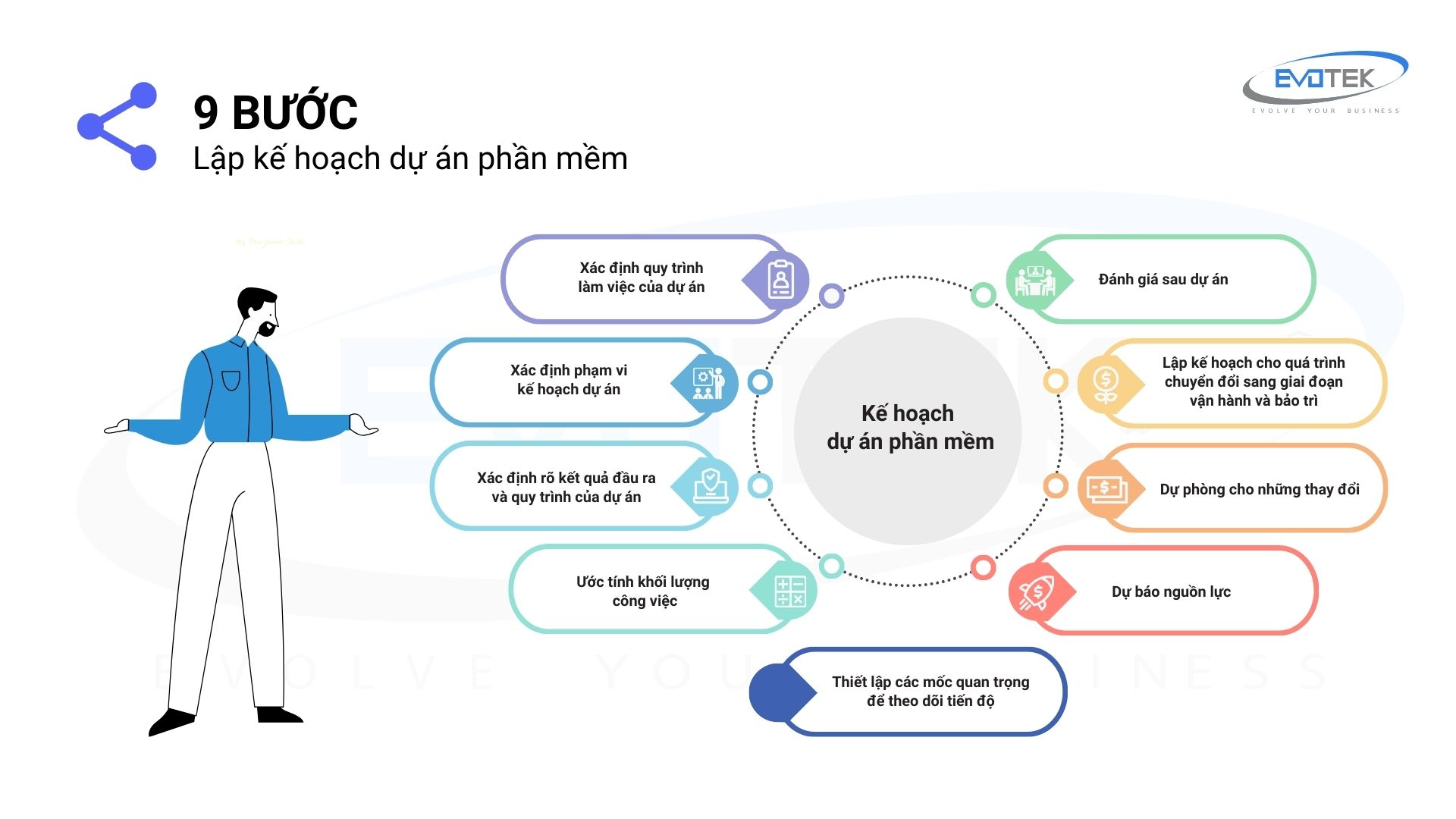
Để xây dựng một kế hoạch phát triển phần mềm hiệu quả và toàn diện, điểm khởi đầu quan trọng là xác định rõ ràng đầu vào và đầu ra mong muốn. Đầu vào bao gồm tất cả các tài liệu mô tả, thông tin, yêu cầu cần thiết cho dự án đề xuất, bao gồm cả những yêu cầu, ràng buộc từ phía đơn vị gia công phần mềm. Đầu ra, đại diện cho các mục tiêu, sản phẩm hoặc kết quả dự kiến sẽ đạt được thông qua quá trình phát triển, phù hợp với khả năng đáp ứng của đơn vị gia công.
Để thiết lập các thông số này một cách chính xác, việc tổ chức các cuộc họp với tất cả các bên liên quan của dự án, bao gồm cả đại diện từ đơn vị gia công phần mềm, là điều vô cùng quan trọng. Những cuộc họp này sẽ tạo cơ hội để thảo luận và giải quyết các vấn đề then chốt như:
- Tài liệu nào đã được chuẩn bị và liên quan đến dự án?
- Những tài liệu này cung cấp thông tin gì và có đầy đủ không? Đơn vị gia công có yêu cầu bổ sung tài liệu nào không?
- Công việc nghiên cứu hoặc tài liệu bổ sung nào cần phải được thực hiện để bổ sung cho các tài liệu hiện có, đáp ứng yêu cầu của cả bên dự án và đơn vị gia công?
- Chi tiết nào cần được đưa vào trong kế hoạch phát triển phần mềm để phối hợp với quy trình làm việc của đơn vị gia công?
Bằng cách tham khảo ý kiến của tất cả các bên liên quan, bao gồm cả đơn vị gia công phần mềm, nhóm dự án sẽ có được góc nhìn toàn diện về các yêu cầu, hạn chế và kỳ vọng từ các phía khác nhau. Từ đó, họ có thể xây dựng một kế hoạch phát triển phần mềm phù hợp với bối cảnh cụ thể, đáp ứng các đầu vào và hướng tới đạt được các đầu ra mong muốn, đồng thời đảm bảo sự phối hợp nhịp nhàng với đơn vị gia công.
1.Xác định quy trình làm việc của dự án
Trước khi đi vào các chi tiết của kế hoạch phát triển phần mềm, việc đầu tiên cần làm là xác định rõ ràng quy trình làm việc dự án ở cấp độ cao nhất. Điều này đòi hỏi phải nhìn nhận toàn bộ vòng đời của dự án, từ giai đoạn ý tưởng ban đầu cho đến giai đoạn hoàn tất cuối cùng, và chia nhỏ nó thành các giai đoạn chính. Một ví dụ điển hình có thể bao gồm các giai đoạn như:
Khởi động > Lập kế hoạch > Triển khai > Phân phối > Kết thúc.
Trong trường hợp hợp tác với đơn vị gia công phần mềm, quy trình làm việc cũng cần phải xác định rõ vai trò, trách nhiệm và cách thức tham gia của đơn vị gia công trong từng giai đoạn.
Trong quá trình xác định các giai đoạn này, điều quan trọng là không được tập trung quá mức vào các giai đoạn đầu và cuối mà bỏ qua các giai đoạn ở giữa. Nhiều khi, các nhà phát triển có xu hướng chú ý nhiều đến giai đoạn khởi động và phân phối trong khi lơ là việc lập kế hoạch và triển khai thực tế. Tuy nhiên, việc bỏ qua các giai đoạn trung gian này có thể dẫn đến những thiếu sót nghiêm trọng trong quá trình phát triển và phối hợp với đơn vị gia công.
Do đó, bước đầu tiên trong việc lập kế hoạch dự án là xây dựng một quy trình làm việc chỉnh chu, nắm bắt được toàn bộ chu kỳ sống của dự án, sự liên kết giữa các giai đoạn chính và vai trò của đơn vị gia công trong từng giai đoạn. Quy trình này sẽ đóng vai trò như một bản đồ đường, giúp nhóm dự án và đơn vị gia công có cái nhìn tổng quan và có thể đi sâu hơn vào các hoạt động cụ thể trong từng giai đoạn. Bằng cách tuân thủ nghiêm ngặt quy trình làm việc này, nhóm phát triển và đơn vị gia công sẽ có thể duy trì sự nhất quán và đảm bảo rằng không có giai đoạn nào bị bỏ qua hoặc đánh giá sai.
2. Xác định phạm vi kế hoạch dự án
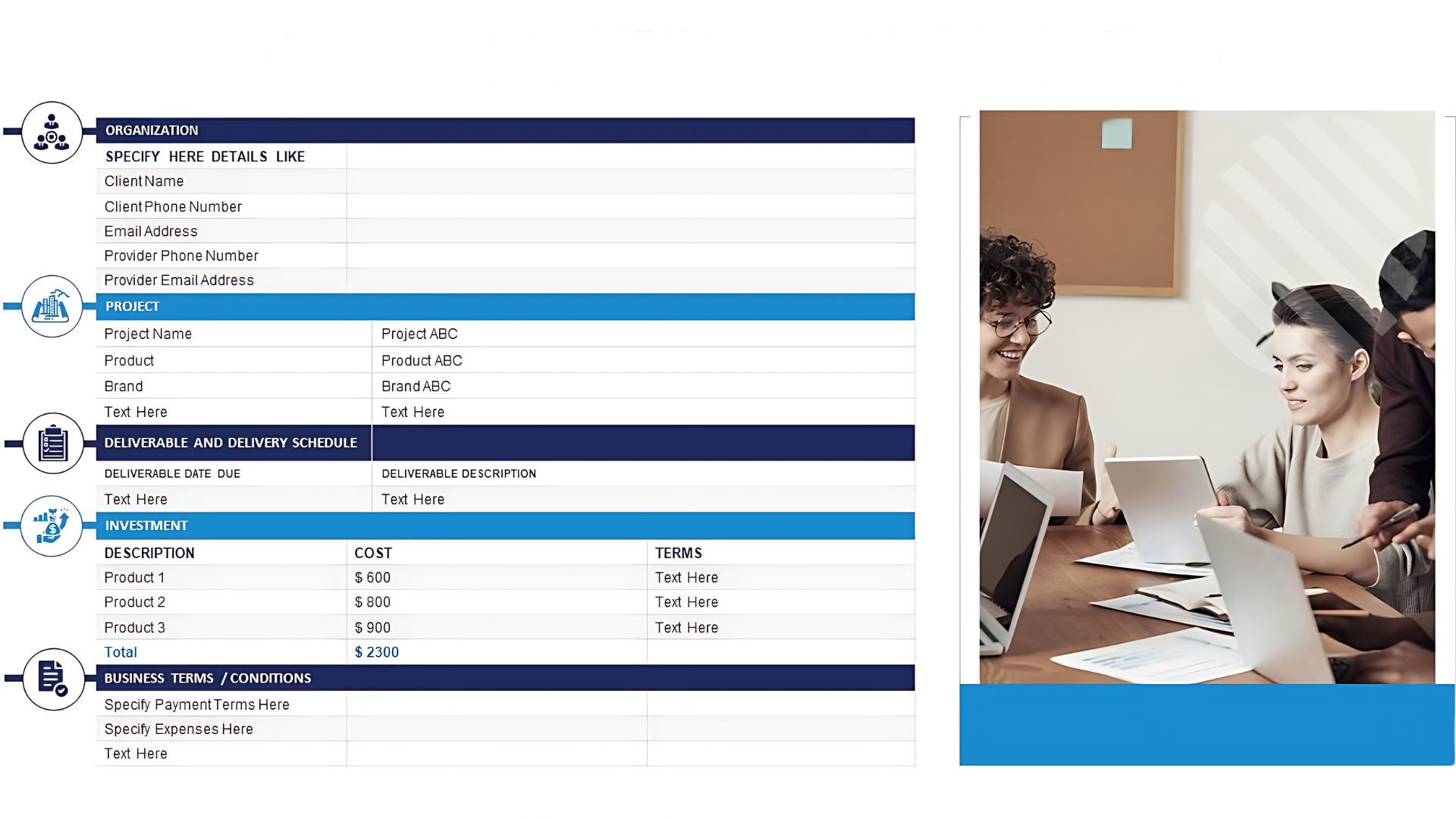
Một trong những quyết định quan trọng khi xây dựng kế hoạch dự án là phải xác định rõ ràng phạm vi mà kế hoạch sẽ bao trùm. Liệu kế hoạch sẽ bao quát toàn bộ dự án hay chỉ tập trung vào một phần nhất định? Quyết định này sẽ phụ thuộc vào mức độ phức tạp, thời lượng dự kiến của dự án và phạm vi công việc được giao cho đơn vị gia công phần mềm.
Đối với các dự án nhỏ, có khả năng hoàn thành trong vòng 6 tháng, việc lập kế hoạch chi tiết cho toàn bộ vòng đời là điều cần thiết. Tuy nhiên, với các dự án lớn, kéo dài nhiều năm hoặc có phần lớn công việc được giao cho đơn vị gia công, chỉ xây dựng một kế hoạch duy nhất bao trùm toàn bộ thời gian là không thực tế. Càng dự án dài hạn, khả năng các ước tính ban đầu bị sai lệch càng cao do ảnh hưởng của các yếu tố bất định có thể phát sinh trong tương lai, bao gồm cả những thay đổi từ phía đơn vị gia công.
Do đó, đối với các dự án dài hơn 6 tháng hoặc có phần lớn công việc được giao cho đơn vị gia công, cách tiếp cận khôn ngoan là chia nhỏ quá trình lập kế hoạch thành từng giai đoạn. Bước đầu tiên là xây dựng kế hoạch chi tiết cho 6 tháng đầu tiên hoặc cho phần công việc được giao cho đơn vị gia công trong giai đoạn đầu, trong đó các yêu cầu, rủi ro và khả năng đáp ứng của đơn vị gia công có thể được dự đoán chính xác hơn. Sau đó, khi giai đoạn đầu tiên kết thúc, nhóm dự án sẽ ngồi lại với đơn vị gia công và thiết lập kế hoạch mới cho giai đoạn tiếp theo dựa trên kinh nghiệm và bài học thu được từ giai đoạn trước.
3. Xác định rõ kết quả đầu ra và quy trình của dự án
Việc xác định rõ ràng kết quả đầu ra mong muốn và quy trình phát triển phần mềm là điều cực kỳ quan trọng, đặc biệt khi hợp tác với đơn vị gia công phần mềm. Việc thiếu sự thống nhất về những yếu tố này giữa các bên liên quan, bao gồm cả đơn vị gia công, có thể dẫn đến nhiều hệ lụy nghiêm trọng sau này, bao gồm sự gián đoạn, lãng phí nguồn lực do phải thay đổi đáng kể phạm vi dự án.
Trước tiên, các nhà phát triển cần có cái nhìn rõ nét về điểm đến cuối cùng của dự án, tức là hình dung được trạng thái “thành công” mà họ đang hướng tới. Làm rõ kết quả đầu ra này sẽ đảm bảo tất cả các bên liên quan, bao gồm cả đơn vị gia công, hiểu rõ mục tiêu tổng thể và cùng hướng đến mục tiêu chung. Thông qua quá trình này, họ có thể loại bỏ những bất đồng quan điểm và kỳ vọng khác nhau ngay từ đầu, tránh những rủi ro phát sinh muộn hơn.
Bên cạnh việc xác định rõ ràng kết quả đầu ra, điều quan trọng không kém là phải làm rõ quy trình phát triển phần mềm sẽ được áp dụng để đạt được mục tiêu đó, đồng thời xác định rõ vai trò, trách nhiệm và cách thức tham gia của đơn vị gia công trong quy trình này. Có nhiều phương pháp và cách tiếp cận khác nhau, mỗi phương pháp có những ưu và nhược điểm riêng phù hợp với bối cảnh và nhu cầu khác nhau của dự án. Do đó, tất cả các bên liên quan, bao gồm cả đơn vị gia công, cần có sự đồng thuận về phương pháp sẽ được sử dụng, cách thức phối hợp giữa các bên và những điều kiện tiên quyết cần thiết để áp dụng thành công phương pháp đó.
4. Ước tính khối lượng công việc
Sau khi xác định rõ ràng kết quả đầu ra mong muốn và quy trình phát triển phần mềm, bước tiếp theo quan trọng là ước tính chính xác khối lượng công việc cần thiết để đạt được thành công, bao gồm cả phần công việc được giao cho đơn vị gia công. Đây là một giai đoạn quyết định, đòi hỏi sự tham gia của toàn bộ nhóm dự án và đơn vị gia công, cũng như áp dụng các kỹ thuật ước tính khoa học, khách quan.
Trong quá trình này, các thành viên nhóm và đại diện từ đơn vị gia công phải tránh xa việc chịu ảnh hưởng hoặc bị chi phối bởi bất kỳ đề xuất hay ý kiến sẵn có nào về thời gian hoàn thành các nhiệm vụ cụ thể. Làm như vậy có thể dẫn đến những ước tính thiếu chính xác, ảnh hưởng đến toàn bộ kế hoạch dự án. Thay vào đó, tất cả các bên liên quan cần được tạo điều kiện chia sẻ quan điểm và ước tính của riêng mình một cách tự do, khách quan.
Để đảm bảo tính khách quan và chính xác cao nhất, chúng tôi khuyến nghị sử dụng Planning Poker trong Agile. Kỹ thuật này yêu cầu tất cả các thành viên nhóm và đại diện đơn vị gia công đưa ra ước tính riêng về khối lượng công việc mà không bị ảnh hưởng hoặc can thiệp bởi các ý kiến khác. Sau đó, các ước tính này sẽ được đánh giá, tổng hợp để tìm ra con số hợp lý nhất, phù hợp với năng lực của cả nhóm dự án và đơn vị gia công.
Đây là một bước quan trọng để xây dựng nền tảng vững chắc cho kế hoạch dự án, đảm bảo các nguồn lực và thời gian được phân bổ phù hợp với nhu cầu thực tế, cũng như khả năng đáp ứng của đơn vị gia công, tăng khả năng thành công của dự án.
5. Thiết lập các mốc quan trọng để theo dõi tiến độ
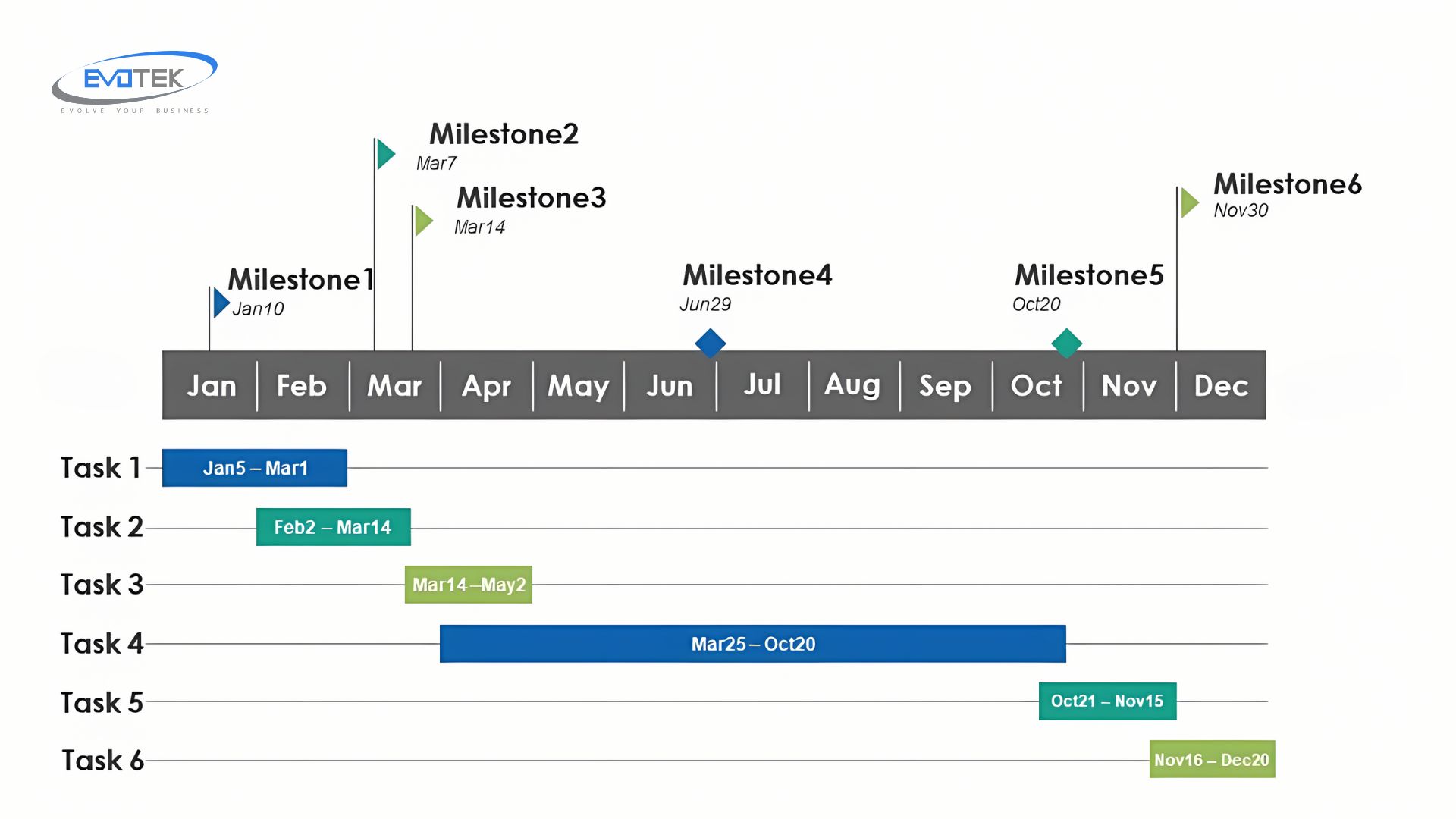
Trong quá trình triển khai một dự án phần mềm, đặc biệt khi liên quan đến cam kết với khách hàng hoặc đối tác, việc xác định rõ ràng các mốc quan trọng là một yếu tố hữu ích để theo dõi sự tiến triển. Những mốc này có thể đánh dấu các giai đoạn chính như “hoàn thành thiết kế”, “xây dựng nguyên mẫu”, “bàn giao công việc cho đơn vị gia công” hoặc “phân phối sản phẩm đầu tiên”. Với những mốc rõ ràng này, tổ chức của bạn, đơn vị gia công và các bên liên quan có thể theo dõi thường xuyên hơn quá trình làm việc để đảm bảo tiến độ phù hợp với kế hoạch.
Thực tế, một số tổ chức thậm chí có thể đưa vào các điều khoản cụ thể trong hợp đồng với đơn vị gia công liên quan đến việc chậm trễ các mốc quan trọng đã thỏa thuận, cho phép họ có quyền xem xét lại hợp tác nếu cần thiết. Điều này nhấn mạnh tầm quan trọng của việc xác định và tuân thủ các mốc tiến độ chính xác với đơn vị gia công.
Tuy nhiên, các mốc quan trọng không chỉ đơn thuần phục vụ lợi ích của tổ chức mà còn giúp duy trì động lực và tập trung cao độ cho cả nhóm dự án và đơn vị gia công. Bằng cách thiết lập rõ ràng các mốc tiếp theo cần đạt được, mọi bên có thể định hướng nỗ lực và nguồn lực vào việc giao hàng các sản phẩm phần mềm càng sớm càng tốt. Họ biết rõ những gì cần làm và có thể tập trung hoàn toàn vào mục tiêu đó mà không bị phân tâm, đồng thời phối hợp nhịp nhàng với nhau.
6. Dự báo nguồn lực
Với việc đã xác định được khối lượng công việc và các mốc quan trọng của dự án, bước tiếp theo là dự báo nguồn lực cần thiết cho từng giai đoạn, bao gồm cả nguồn lực từ phía đơn vị gia công. Trong quá trình xây dựng nhóm phát triển, cần xác định rõ thời điểm mỗi thành viên, bao gồm cả nhân sự của đơn vị gia công cần tham gia vì không phải lúc nào cũng đòi hỏi toàn bộ nguồn lực.
Ví dụ, giai đoạn lập kế hoạch và thiết kế ban đầu thường đòi hỏi nỗ lực lớn từ nhóm thiết kế và các bên liên quan hơn là các giai đoạn phát triển. Ngược lại, nhóm phát triển và đơn vị gia công sẽ đóng vai trò quan trọng hơn trong các giai đoạn triển khai.
Để xây dựng nhóm dự án và kế hoạch hợp tác hiệu quả với đơn vị gia công, cần cân nhắc các yếu tố như:
- Phạm vi dự án và phân công công việc cho từng đơn vị
- Tốc độ vòng đời phát triển và khả năng đáp ứng của đơn vị gia công
- Kỹ năng kỹ thuật của thành viên trong nhóm và nhân sự của đơn vị gia công
- Quy trình phân phối, bàn giao và sự phụ thuộc vào tiến độ của đơn vị gia công
7. Dự phòng cho những thay đổi
Trong bất kỳ dự án phát triển phần mềm nào, điều không tránh khỏi là sẽ luôn có những vấn đề và trở ngại nảy sinh từ các bên liên quan. Do đó, việc lên kế hoạch chuẩn bị cho những thay đổi bất ngờ là điều cần thiết. Trước khi khởi động dự án, một biện pháp hữu ích là tổ chức một cuộc họp giữa nhóm dự án và đại diện của đơn vị gia công để phân tích và đánh giá tất cả các rủi ro, vấn đề tiềm ẩn có thể xảy ra từ cả hai bên cùng với các biện pháp giảm thiểu rủi ro tương ứng.
Ngay cả khi không tiến hành cuộc họp chính thức này, các nhà phát triển vẫn cần dành thời gian chuẩn bị cho những thay đổi và chậm trễ có thể phát sinh trong quá trình triển khai dự án. Việc xác định trước các vấn đề tiềm năng và phương án xử lý tương ứng sẽ giúp nhóm dự án chủ động hơn trong việc quản lý rủi ro. Một cách tiếp cận hiệu quả là duy trì nhật ký ghi lại các vấn đề, rủi ro thực tế cũng như danh sách các biện pháp giảm thiểu để kiểm soát mọi tình huống trong suốt dự án.
Bằng cách đưa việc chuẩn bị cho những thay đổi vào kế hoạch ngay từ đầu, nhóm dự án sẽ có khả năng phản ứng linh hoạt và hiệu quả hơn khi đối mặt với những tình huống bất ngờ, đảm bảo duy trì được tiến độ và chất lượng của dự án.
8. Lập kế hoạch cho quá trình chuyển đổi sang giai đoạn vận hành và bảo trì
Mặc dù phần lớn nỗ lực trong một dự án phát triển phần mềm tập trung vào các giai đoạn phân tích, thiết kế và triển khai, nhưng không thể bỏ qua kế hoạch cho giai đoạn chuyển đổi quan trọng sau khi bàn giao sản phẩm. Nhiều dự án vẫn có thể gặp trở ngại trong giai đoạn cuối cùng này nếu không được chuẩn bị đầy đủ.
Để chuẩn bị cho quá trình chuyển tiếp suôn sẻ, điều cần thiết là phải phối hợp chặt chẽ với nhóm cung cấp dịch vụ vận hành và bảo trì ngay từ giai đoạn đầu. Những nhóm này thường có danh sách kiểm tra riêng với các yêu cầu phi chức năng cần được đáp ứng, và việc đưa những yêu cầu này vào kế hoạch phát triển sớm sẽ mang lại nhiều lợi ích.
Cần phải dành đủ thời gian và nguồn lực để bàn giao hệ thống hoàn chỉnh cho nhóm sẽ tiếp quản vận hành và bảo trì. Bên cạnh đó, một kế hoạch hỗ trợ sau khi đưa vào sử dụng cũng là điều cần thiết, nhằm đảm bảo quá trình chuyển giao diễn ra trôi chảy, không gây gián đoạn cho hoạt động kinh doanh. Giai đoạn quản lý dự án này đóng vai trò quan trọng trong việc duy trì mối quan hệ tốt đẹp với khách hàng và để lại ấn tượng tích cực về toàn bộ dự án.
9. Đánh giá sau dự án
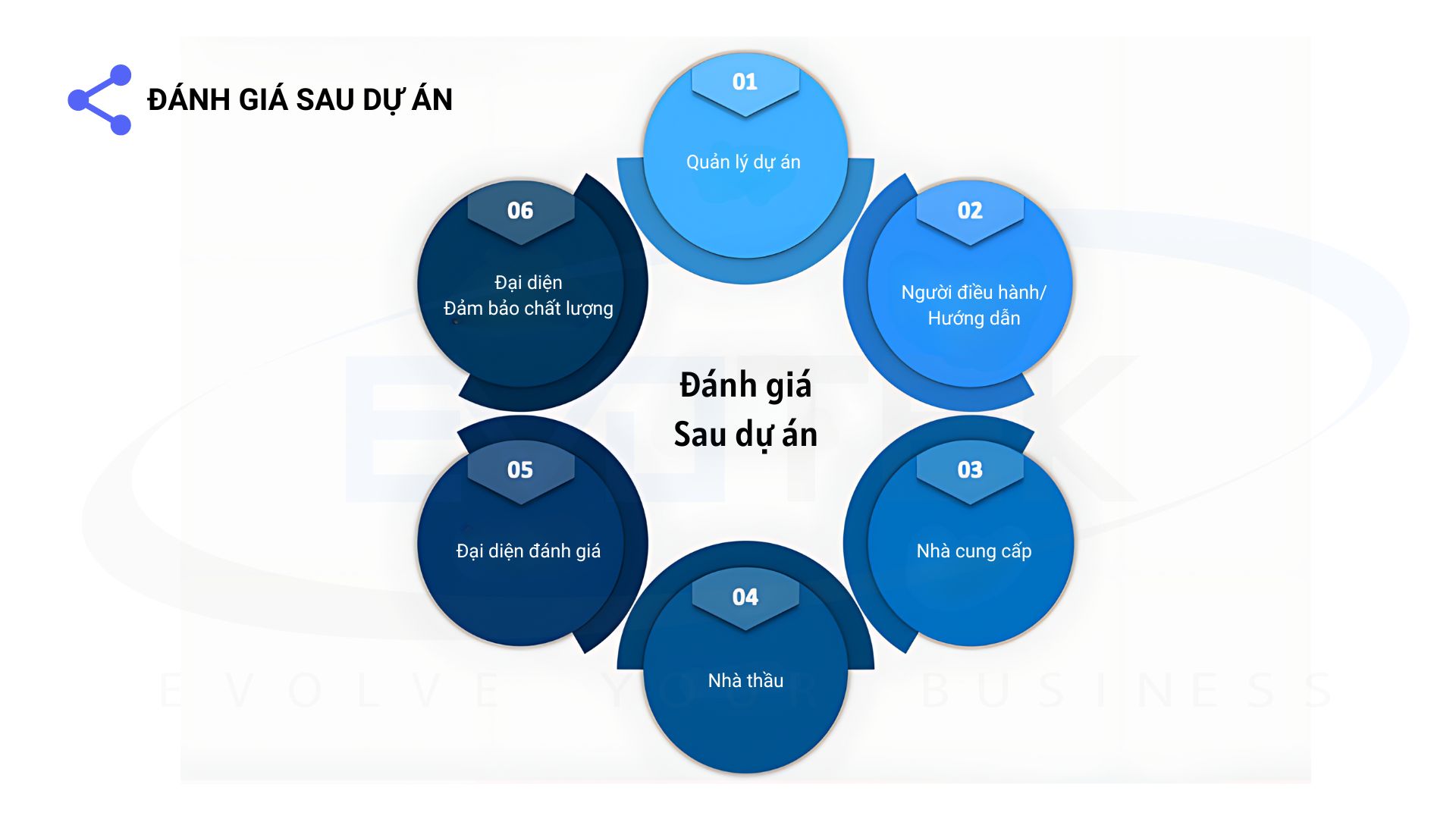
Sau khi hoàn thành một dự án phát triển phần mềm, việc tiến hành đánh giá và rút kinh nghiệm là bước quan trọng không thể bỏ qua. Tuy nhiên, thực tế là các nhóm dự án thường bị giải tán nhanh chóng và nguồn lực được phân bổ lại cho các nhiệm vụ khác, khiến giai đoạn đánh giá này bị xem nhẹ hoặc bỏ lỡ. Bỏ qua giai đoạn đánh giá có nghĩa là các dự án tương lai có thể phải tốn thời gian và nguồn lực để học lại những bài học tương tự, dẫn đến sự lãng phí không cần thiết. Để thu thập thông tin và phản hồi đầy đủ, các câu hỏi mở sau đây nên được đặt ra trong quá trình đánh giá:
- Những bài học quan trọng nào đã được rút ra từ dự án này?
- Khía cạnh nào đã diễn ra tốt đẹp và có thể được nhân rộng trong các dự án tương lai?
- Những vấn đề hay tình huống nào đã không diễn ra như mong đợi và cần có biện pháp khắc phục cho các dự án tiếp theo?
- Liệu các mục tiêu ban đầu của dự án đã được đáp ứng hay chưa?
- Những lợi ích cụ thể nào mà dự án đã mang lại cho tổ chức?
Bằng cách thực hiện tốt quá trình đánh giá sau dự án, các nhà phát triển và quản lý có thể xác định rõ những điểm mạnh, điểm yếu và cơ hội cải thiện trong các quy trình, giúp họ không ngừng hoàn thiện năng lực, từ đó nâng cao khả năng thành công cho các dự án phần mềm trong tương lai.
Đánh giá sau dự án là bước cuối cùng nhưng vô cùng quan trọng trong quá trình phát triển phần mềm. Đừng bỏ lỡ cơ hội quý báu này để học hỏi, phản hồi và cải tiến liên tục, đảm bảo mỗi dự án phần mềm mới đều vượt trội hơn dự án trước đó.
Kết luận
Phát triển phần mềm linh hoạt thường được coi là ưu tiên hơn là “tuân theo kế hoạch”. Trong thực tế, về mặt lý thuyết, có thể chỉ cần thành lập một nhóm các nhà phát triển và để họ bắt đầu làm việc, nghiên cứu, giải quyết các vấn đề khi họ tiến hành dự án. Tuy nhiên, phương pháp này chỉ có thể thành công với những dự án nhỏ và đơn giản nhất.
Khi các dự án trở nên phức tạp hơn, việc lập kế hoạch chi tiết và cẩn thận là điều cần thiết. Mặc dù phát triển phần mềm linh hoạt ủng hộ việc thay đổi và thích ứng, nhưng một kế hoạch dự án vững chắc vẫn đóng vai trò quan trọng trong nhiều bối cảnh dự án, giúp quản lý kết quả, nguồn lực và đảm bảo tuân thủ các ràng buộc bên ngoài. Việc phát triển một kế hoạch như vậy là rất quan trọng để tránh quản lý ngân sách yếu kém, thất bại về lịch trình và đảm bảo dự án đạt được thành công.
Bạn càng chuẩn bị nhiều công việc để xây dựng một kế hoạch dự án vững chắc thì bạn càng có nhiều khả năng đạt được các dự án phần mềm thành công, đúng hạn và phù hợp với ngân sách. Kế hoạch dự án chi tiết sẽ định hướng toàn bộ nhóm phát triển, giúp họ duy trì tập trung và đạt được mục tiêu cuối cùng: cung cấp phần mềm chất lượng cao đáp ứng các yêu cầu trong khuôn khổ thời gian và ngân sách được xác định trước.
Với 9 bước cơ bản trên, hy vọng bạn có thể xây dựng một kế hoạch phát triển phần mềm vững chắc. Tại Evotek, chúng tôi luôn sẵn sàng hỗ trợ bạn trong mọi khâu của quy trình phát triển phần mềm nhờ đội ngũ chuyên gia giàu kinh nghiệm.
Hãy liên hệ với chúng tôi để được tư vấn thêm!

 English
English 日本語
日本語 한국어
한국어 简体中文
简体中文